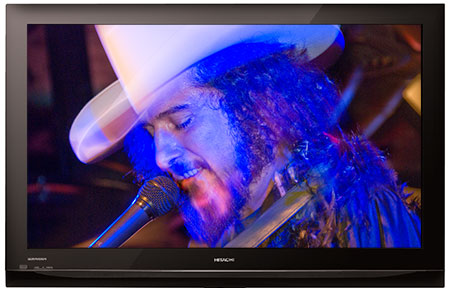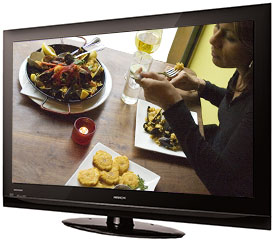
Dick De Jong
December 5, 2008
HDTV Solutions
For me plasmas are the comfort food in the HDTV kitchen. They soothe our souls with a refreshing feast of rich colors.
True to that tradition, the Hitachi Ultravision P50V702 serves up some mighty tasty visual vittles.
Now add to that its 50" size and the P50V702 becomes the HDTV version of a Thanksgiving dinner - big enough for family and friends to relish.
For those of you who enjoy chewing on technical bones, this 1080p plasma features 16 bit processing, which gives it a capability of reproducing over 281 trillion colors.
For the rest of us, let's eat.
(Editor's Note: The P50V702 is just below its sibling, the P50X902, at the top of Hitachi's plasma product line. The two offer many of the same features. I feel that they are similar enough that this review can be applied to both. Though please be mindful that the X902 sports a high gloss crystal frame and is part of Hitachi's Director's Series with additional picture tuning features, a learning remote and a 2 year warranty.)
With a 50" display, you might expect a larger bezel and indeed this HDTV sports a two and a half inch frame around its anti-reflective screen, with an extra two inches on the bottom to encase the two 10W speakers. Hitachi labels the design as High Gloss Japan Black.
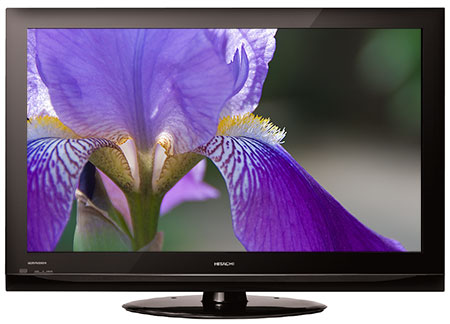
The front of the P50V702 is adorned by the HITACHI name at the bottom center and ULTRAVISION on the left. Below that are the Power indicators light and the remote control and ambient light sensor.
The TV can measure the light in the room and adjust the contrast of the display accordingly. Unless you enjoy fooling poor defenseless light sensors, make sure that you leave that area clear and with no direct lights hitting it.
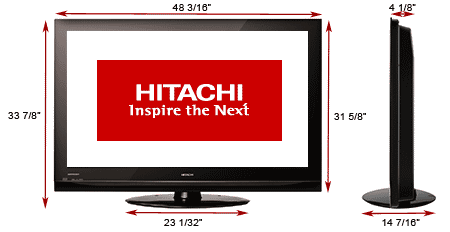
All 50" TVs require at least two people to move them. This Ultravision demands extra muscle because its sturdy stand pushes the weight of the P50V702 to almost 104 pounds.
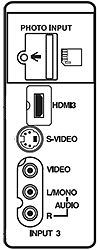
The added strain to your back is worth it because not only does the TV swivel in the stand 30 degrees in either direction, the base is powered. With a touch of a button on the remote, the TV rotates with an elegant quiet smoothness. You just need to remember to give the screen an unimpeded path.
All the video and audio connections are aggregated on the left end of the TV. On the side, next to the operational buttons (Power, Volume, Channel), is a small convenience connection panel with one HDMI input, one Composite Video In with a stereo Audio In, one S-Video, and an SD Card reader for uploading JPEG photos.
Adjacent to this panel is a larger one that faces the back and contains two more HDMI inputs, two Component (Y, Pb, Pr) with stereo Audio Ins, and one digital Audio Out.
Also included is an IR Out, which sends an infrared signal to your external components allowing you to control them with the TV's remote. The Swivel connector is where you plug in the small cable that also attaches to the stand allowing the power swivel feature.
Please notice that the RS232C port is for special AV control use only. This is not a VGA input. In fact, there is none. If you wish to connect your computer to this Hitachi, you will need to use an HDMI input.
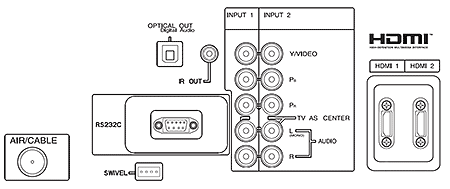
The one RF antenna connector links to integrated NTSC/ATSC/QAM tuners. Since the tuner system is Clear QAM compatible, you can attach your cable TV signal directly into the RF connector and tune in unscrambled cable stations.
For those concerned about the DTV transition coming up, the ATSC tuner is the key. With the proper antenna, you will be able to tune in digital signals broadcast over the air.
I applaud Hitachi for including an SD Card reader for uploading photos onto the TV, but the Photo Viewer implementation is one of the weakest that I have encountered lately.
To begin, the manual lists some rather complicated file naming conventions for the JPEGs. Luckily, both the Nikon and Panasonic cameras that I tried have compatible file names. But when I attempted to upload JPEGs that I worked on in Photoshop, the TV would not recognize the card. I followed the naming rules and these are images that other TV photo viewers accept.

It seems that you are safest uploading images directly from your camera. Of course, if the camera doesn't use SD memory cards, you will need to transfer the images to an SD card.
Once the photos are uploaded, the Photo Viewer features are limited. For example, you have no transition options and the slide intervals are only five, ten and thirty seconds.
The good news is that photos look great on this Ultravision plasma. And you can fine tune the image in the Photo picture mode.
The manual describes the TV's Split Picture, Picture-in-Picture and Picture-outside-Picture capabilities with controls for positioning insets. You are limited in the combinations of sources. For example, you cannot PIP two HDMI sources. I couldn't test these features because the remote that came with my review unit did not have the PIP button to access PIP commands.
I have included a photo of the remote control that is described in the manual. (You'll see the PIP on the third row from the bottom.) From the look of this remote, I think I would have preferred it over the one that I was sent. But other than that, I can't really comment on it.
Hitachi offers one more feature that can be especially useful for those watching TV broadcast over the air. The TV Guide On Screen Interactive Program Guide downloads to the TV when it's off. In the initial setup, you input your zip code and the guide provides the weekly programming schedule for the channels that you have scanned.
The EPA is now publishing a list of ENERGY STAR qualified TVs. Since this endeavor only started in November 2008, the list is not expansive but it does include the Hitachi P50V702.

The EPA states that this Ultravision's On Mode Power is 313.05 W and Standby Power Consumption is .41 W. Based on the formula that the TV is on five hours a day and in Standby for the other 19, the Estimated Annual Energy Use is 574 kWh/year.
You need to check your electric bill to see how much you are paying for a kWh. The national average is 10.4 cents. Doing the multiplication, at that rate, the yearly energy cost is $59.60.
When we measured power consumption using a watt meter, called Watts up? Pro, the readings varied wildly from shot to shot. In Dynamic mode, the range was from 380 to 450 W. In the less bright Night mode, the variation was even greater, from 240 to 390 W.
At first, we were puzzled by the EPA Standby rating of .41 W. When we turned this plasma off, the meter settled at about 15.4 W. Though when we turned the TV back on, the audio came on almost immediately and the video was not far behind with a picture in about two seconds, which is the fastest response from standby that we have seen.
We searched in all the TV's menus to try to discover how to get to a standby that took almost no power. This Hitachi does have a Picture Energy Saving mode, but it is only in effect when the TV is on.
After giving up our quest, we later decided to turn off the TV with the Power button on the side of the TV. Like all good couch potatoes, we always turn off the TV with the remote control, but that seems to put the TV into the 15 W standby mode.
When we switched if off at the set, our meter reading dropped to zero. For this TV, this would be a good habit to encourage. Except if you are using the TV Guide feature, which requires the tuner to remain active for certain periods of time. (See page 5 of the manual for more energy saving tips.)
To calibrate the TV, we use the the Blu-ray version of the Digital Video Essentials DVD called HD Basics. We are playing the DVD on a Pioneer BDP-94HD Blu-ray player connected to the HDTV with an HDMI cable.
We use the test patterns to adjust black level, white level, and color bias. The player is set to output a 1080p signal, which is the native resolution of the P50V702.
When you first pull this HDTV out of its box, you go through an initial setup. To begin, you are asked to choose the Retail or Home setting. Unless you are planning to open a showroom in your living room, pick Home. This choice has an obvious repercussion and a hidden one.
If you opt for Retail, the TV defaults to the Dynamic picture mode, which is much too vibrant for my tastes. The gotcha with the Retail setting is that any picture adjustments that you make are not remembered when you turn off the TV.
This makes sense when you imagine all the fiddling fingers in a Big Box store. But I was baffled when my fine tuning kept disappearing until I realized that my review unit came to me in Retail mode. Once I went into the setup menu and changed it, all was copacetic.
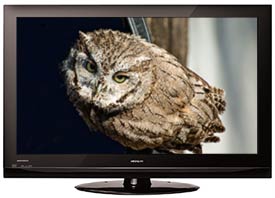
Now back to my usual pre-calibration routine. First, I pick a Picture Mode. With this Ultravision, the choices are Day, Night and the dreaded Dynamic.
Since the sun was still out, I chose Day. I later returned and also adjusted the Night mode. There is a Day/Night button on the remote that allows you to easily switch from one to the other.
Next I find the Color Temperature control and cycle through the options to find my preference. For me, the difference in the choices are most obvious when looking at whites.
With this Hitachi, you have High (cooler, bluer whites), Medium (fairly neutral whites), Standard (a bit warmer, yellower whites), and D. Cinema, which the manual describes as "for color to match the cinema accurately." For me, D. Cinema is just too warm and yellow. I vacillated between Medium and Standard.
With LCDs, I would adjust the Backlight. Plasmas don't have a Backlight setting. The P50V702 does have a light sensor and it varies the Contrast depending on the amount of light in the room. Therefore, if you turn the Light Sensor on, the Contrast control is grayed out in the menu, meaning that you cannot tune it.
If you are creating a Day setup, then normally you would turn on the Light Sensor. For the Night mode in a room with controlled lighting, you could turn if off and adjust the Contrast directly.
For the Day mode, I didn't deviate too far from the defaults. Brightness and Color (Saturation) were bumped up a notch or two. I moved Tint (Hue) a couple of steps towards Red. Sharpness stayed around midway on the slider.
Hitachi offers a setting called Color Space with two options, "VIBRANT for highly saturated colors or Auto STD/x.v.Color for more natural colors." As many of you know, I am not a big Vibrant proponent, but I do like that you have the choice.
One of the reasons I prefer plasmas is that they are able to generate rich satisfying colors without resorting to over brightening or over saturating. But I have been subsisting on a diet of LCDs lately and if you are jonesing for that super-saturated sugar rush, then you should be satiated with Vibrant. For the more temperate eyeballs in the crowd, I would recommend Auto STD/x.v.Color.
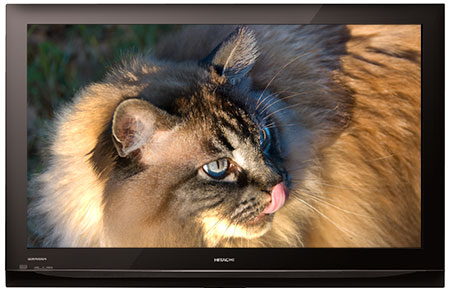
With those slight tweaks, this Ultravision was living up to its name and was exhibiting the characteristics that I have come to admire in a plasma HDTV. Colors were true and full bodied because the underlying blacks were deep.
If you wish to crank the blacks even more, then experiment with the Black Enhancement feature in the Video Menu. Also, at the bottom of the menu are controls for advanced items like Contrast Mode. The manual actually does a decent job of explaining them. It's worth the time to walk through each and see what setting appeals to you.
Finally, you can select the Aspect Ratio for the display. I usually don't discuss this, but when I was first setting the TV up, I noticed that it was cropping about 5 or 6% of my test patterns, which is more than the 2 to 3% that I usually encounter.
For most people, they would never notice the difference. Indeed, one of the reasons for cropping the image is because it hides the unsightly signal noise that appears around the edges of some broadcast programs. But if you demand a pixel by pixel full screen, then in the Aspect Ratio submenu, choose 16:9 Standard 2. (Standard 1 crops the image.)
As I said, the P50V702 upholds its plasma heritage with solid, not showy, performance. I could set it and forget it. Skin tones were true, colors were rich. And I didn't need to scurry for the remote every time a new program came on.
It doesn't have that razor's edge sharpness that I see in other TVs, but for me, that's a plus. I'm not saying that the P50V702 is soft, rather that it has a more film-like subtlety to it.
If subtle is not your style, you can overindulge in this Ultravision's 16 Bit/281 Trillion Color Capacity by switching the Color Space setting from Auto STD/x.v.Color to Vibrant. I did when watching Pirates of the Caribbean: At World's End.
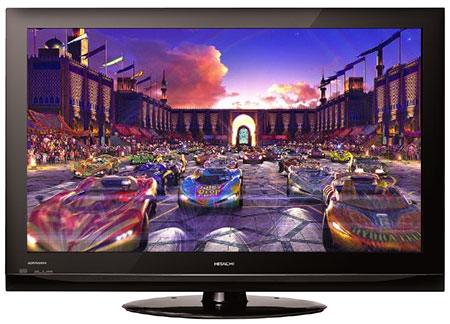
On the other end of the saturation spectrum is our new OMG color reference movie, the Blu-ray of Speed Racer. Unless you are the Sugar Plum Fairy, you'll want to rescue your eyes from hyperglycemic shock by reverting the TV back to the less color drenching Auto STD/x.v.Color.
Even with powerful plasmas, standard definition programs still look, well, standard. Please, to honor your HDTV, feed it high definition material whenever possible.
The audio quality emanating from the pair of 10W speakers is darned good. I know that my expectations are low for integrated speakers, but this Hitachi projected above average audio with some tonal width and depth - definitely fine for every day use. Of course, if you are planning a home theater, step up to a dedicated audio system.
If the thought of a 50" plasma evokes dreams of a home theater, then the Hitachi Ultravision P50V702 is a good candidate for the video centerpiece of that reverie.
